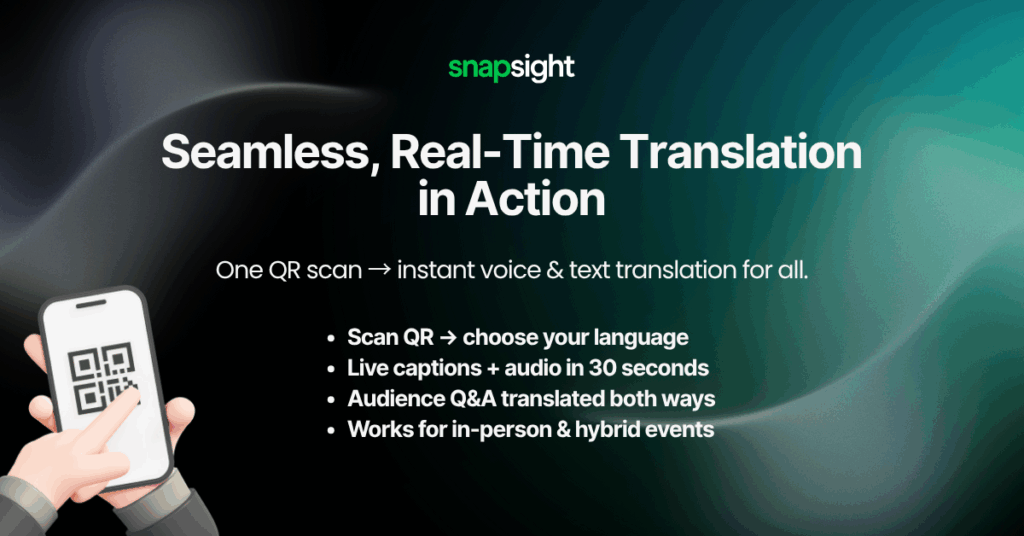Your tech conference just attracted 2,000 registrations from 35 countries. Great news, until you realize your keynote speaker only speaks English while 60% of attendees prefer other languages. This scenario plays out at thousands of events globally, but smart organizers are turning this challenge into a competitive advantage using multi-language content translation strategies.
The Foundation: Smart Language Planning
Before investing in translation technology, analyze your actual needs. Registration data from a recent industry summit revealed surprising patterns: while attendees came from 40 countries, just six languages covered 92% of participants. English, Spanish, Mandarin, Portuguese, Arabic, and French are dominant. The remaining 8% spoke 25 different languages.
This data shapes everything. Instead of attempting to support all 31 languages equally, organizers focused their investment in the real-time translation platform on the core six. They provided full translation for keynotes, workshops, and networking sessions in these languages. For the remaining languages, they offered English-only support with post-event translated recordings.
Smart planning extends to content types. Product demonstrations need word-for-word accuracy. Panel discussions benefit from conversational translation that captures tone and emotion. Networking sessions might only need basic support. Matching translation depth to content purpose maximizes both budget and impact.
Technology That Scales With Your Event
Modern AI speech translation service solutions have revolutionized multi-language events. Gone are interpreter booths, equipment rental nightmares, and distribution delays. Today’s platforms work through any smartphone or laptop.
Here’s how leading events implement this: Attendees enter the session and scan a QR code displayed on screens. They select their preferred language from a simple menu. As speakers present, translated text appears on their device in real-time. Audio translation plays through their earbuds. The entire setup takes under 30 seconds per person.
The technology handles complexity seamlessly. When audience members ask questions, the platform captures their words, translates them for the speaker, then translates the answer back to all languages simultaneously. This creates natural dialogue without awkward interpretation pauses.
For hybrid event translation services, the same system serves both in-person and remote attendees. Virtual participants access translation through the event platform, while on-site attendees use their phones. Everyone experiences the same content quality regardless of location or language.

Content Strategy for Global Audiences
Successful multi-language content translation starts during event planning, not on event day. Consider how Microsoft redesigned their annual developer conference. They now require speakers to submit slides 30 days early for translation preparation. Technical terms get defined in a master glossary. Acronyms are spelled out. Cultural references are flagged for adaptation.
This preparation pays off during live sessions. When a speaker mentions “API integration,” every language receives the correct technical translation, not a literal word conversion. Industry-specific terms maintain their meaning across all audiences.
Speaking style matters too. Presenters who normally race through content learn to pace themselves. They pause between major points. They avoid idioms and colloquialisms. They repeat key concepts using different words. These adjustments improve understanding for everyone, not just non-native speakers.
Managing Live Event Dynamics
Real events bring real challenges. A panelist switches between languages mid-sentence. Technical terms get mispronounced. Network connectivity drops. Successful organizers prepare for these realities.
Create language-specific support channels. Spanish speakers get a dedicated WhatsApp group with Spanish-speaking staff. Chinese attendees receive WeChat support. This immediate, native-language assistance prevents small issues from becoming major problems.
Build flexibility into your schedule. Live translation for online events sometimes requires extra processing time. Add five-minute buffers between sessions. Extend Q&A periods slightly. These small adjustments prevent rushed transitions that leave international attendees behind.
Integration With Content Intelligence
Modern events generate massive amounts of multilingual content. Every session, conversation, and presentation contains valuable insights. Platforms like Snapsight transform this translated content into searchable, analyzable assets.
Post-event, organizers can identify which topics resonated across different language groups. They discover that Japanese attendees focused on technical specifications while French participants engaged more with business strategy discussions. This intelligence shapes future event planning and content development.
The multilingual transcripts become training materials, marketing content, and reference documents. A single keynote translated into six languages creates six pieces of valuable content. Smart organizers leverage this multiplication effect for ongoing engagement.
Key Takeaways
- Prioritize strategically: Focus translation resources on languages that cover 90% of your audience
- Simplify technology: QR code-based platforms eliminate equipment hassles
- Prepare content early: Share materials with translation teams 30 days before events
- Design for flexibility: Build buffer time for translation processing
- Maximize value: Transform translated content into long-term business assets
Transform your next international event with comprehensive multi-language content translation solutions that go beyond basic interpretation to create truly inclusive global experiences.

